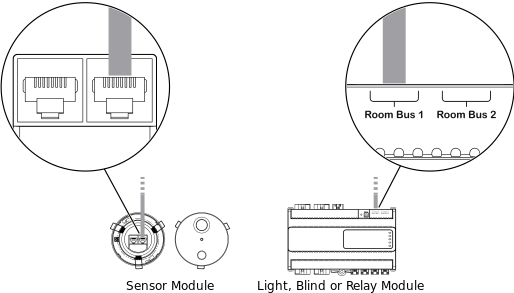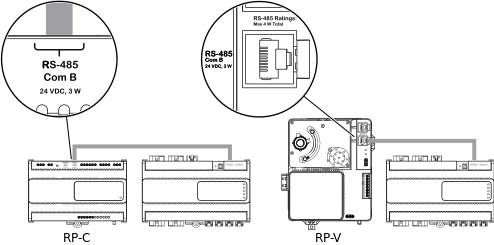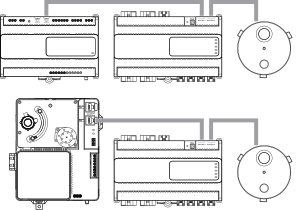The RP controller room bus allows RP controller expansion modules to be connected to the controller for people counting, motion detection, luminosity and sound pressure level measurements, Bluetooth Low Energy based applications, and control of electric lights and window blinds.
Note:
RP controller models with “-M” in the product name do not support the room bus.
The maximum total length of the room bus is 72 m (236 ft). The room bus uses a Cat 5 (or higher) unshielded, straight-through wired cable with eight conductors (four twisted pairs) and RJ45 connectors. The wire size (cross-sectional area) should be 22 to 26 AWG (0.34 to 0.14 mm²). When the RP controller is installed in a space that handles conditioned air or return air, the room bus cables and IP network cables frequently must be plenum-rated to meet applicable building codes.
For more information, see Wiring
.
|
Notice
|
|
LOSS OF COMMUNICATION
Ensure that the total length of the room bus does not exceed 72 m (236 ft).
Use a Cat 5 or higher unshielded twisted pair cable with eight conductors (four twisted pairs), a cross-sectional area of 22 to 26 AWG (0.34 to 0.14 mm
2
), and a rating that meets the requirements of the target environment.
Failure to follow these instructions can result in loss of communication.
|
By default, the RP-C controller's RS-485 Com B port is configured and allocated for the room bus.
For more information, see RP-C Communication Ports
.
Note:
The number of RS-485 communication ports and their location differ between different controller models.
action_zoom_plus_stroke

Figure:
Location of the Room Bus ports and address switches on the RP-C controllers and RP controller expansion modules
Restrictions for Connecting RP Controller Expansion Modules to the RP-C Room Bus
The maximum number of RP controller expansion modules that can be connected to the RP-C room bus, and the restrictions that apply to certain types of the modules, vary depending on the RP-C controller model. In this respect, the RP-C controller models are divided in the following two categories:
RP-C Advanced: RP-C-12A-F-24V, RP-C-12B-F-24V, RP-C-12C-F-24V, and RP-C-16A-F-230V
RP-C Pro and RP-C Pro Plus: RP-C-16B-F-24V, RP-C-16B-F-230V, and RP-C-16C-F-230V
For more information, see RP-C Models
.
Important:
The restrictions listed below only apply to Connected Room Solutions for Buildings. For Connected Room Solutions for Hotels, it is recommended to use the RP-C Pro controller. For additional information on what restrictions apply to Connected Room Solutions for Hotels, see the supplementary document Architecture Guidelines – Hotel Application.
RP-C-12A-F-24V, RP-C-12B-F-24V, RP-C-12C-F-24V, and RP-C-16A-F-230V
To the room bus of the RP-C-12A-F-24V, RP-C-12B-F-24V, RP-C-12C-F-24V, and RP-C-16A-F-230V controller models, you can connect a single RP controller expansion module, or you can connect up to six devices in a daisy-chain configuration.
Note:
When connecting devices to the RP controller room bus through a daisy-chain configuration, the room bus ports on the device are interchangeable.
The RP-C room bus supports up to six connected RP controller expansion modules with the following restrictions:
Maximum of two DALI light modules
Maximum of two SMI blind modules
Maximum of four Multi-sensor or Insight-Sensor devices
action_zoom_plus_stroke

Figure:
Example of supported combination of RP controller expansion modules on the RP-C room bus
Each RP controller expansion module has a rotary switch, which is used to give the device a unique address on the room bus. An RP controller expansion module can be given any address in the range of 1 to 6. Configuring the address 0 means that the device enters maintenance mode and goes offline. Configuring an address in the range of 7 to 9 also means that the device goes offline.
For more information, see RP Controller Expansion Module Room Bus Addressing
. An incorrectly configured switch can cause two devices to have the same address on the room bus, which means that both devices will be offline.
|
Notice
|
|
LOSS OF COMMUNICATION
Ensure that the rotary switch on the RP controller expansion module is configured to give the device a unique room bus address in the range of 1 to 6.
Failure to follow these instructions can result in loss of communication.
|
Table: Room Bus Addresses
|
Address
|
Description
|
|
0
|
Maintenance mode. Device offline.
|
|
1 to 6
|
Valid addresses for devices connected to the room bus of the RP-C-12A-F-24V, RP-C-12B-F-24V, RP-C-12C-F-24V, and RP-C-16A-F-230V controller models.
|
|
7 to 9
|
Addresses not supported by the RP-C-12A-F-24V, RP-C-12B-F-24V, RP-C-12C-F-24V, and RP-C-16A-F-230V controller models or the EcoStruxure Building Operation software. Device offline.
|
Note:
Devices connected to the RP controller room bus through a daisy-chain configuration can be assigned addresses regardless of the order in which the devices appear in the daisy chain. For example, device number 1 can have the address 6, device number 2 can have the address 4, and so on.
RP-C-16B-F-24V, RP-C-16B-F-230V, and RP-C-16C-F-230V
To the room bus of the RP-C-16B-F-24V, RP-C-16B-F-230V, and RP-C-16C-F-230V controller models, you can connect a single RP controller expansion module, or you can connect up to nine devices in a daisy-chain configuration.
Note:
When connecting devices to the RP controller room bus through a daisy-chain configuration, the room bus ports on the device are interchangeable.
The RP-C room bus supports up to nine connected RP controller expansion modules with the following restrictions:
Maximum of two DALI light modules
Maximum of two SMI blind modules
Maximum of seven Multi-sensor or Insight-Sensor devices
action_zoom_plus_stroke

Figure:
Example of supported combination of RP controller expansion modules on the RP-C room bus
Each RP controller expansion module has a rotary switch, which is used to give the device a unique address on the room bus. An RP controller expansion module can be given any address in the range of 1 to 9. Configuring the address 0 means that the device enters maintenance mode and goes offline.
For more information, see RP Controller Expansion Module Room Bus Addressing
. An incorrectly configured switch can cause two devices to have the same address on the room bus, which means that both devices will be offline.
|
Notice
|
|
LOSS OF COMMUNICATION
Ensure that the rotary switch on the RP controller expansion module is configured to give the device a unique room bus address in the range of 1 to 9.
Failure to follow these instructions can result in loss of communication.
|
Table: Room Bus Addresses
|
Address
|
Description
|
|
0
|
Maintenance mode. Device offline.
|
|
1 to 9
|
Valid addresses for devices connected to the room bus of the RP-C-16B-F-24V, RP-C-16B-F-230V, and RP-C-16C-F-230V controller models.
|
Note:
Devices connected to the RP controller room bus through a daisy-chain configuration can be assigned addresses regardless of the order in which the devices appear in the daisy chain. For example, device number 1 can have the address 6, device number 2 can have the address 4, and so on.




 RP-C Controllers
RP-C Controllers
 RP-V Controllers
RP-V Controllers
 RP-C Models
RP-C Models
 RP-V Models
RP-V Models
 RP-C Room Bus
RP-C Room Bus
 RP-V Room Bus
RP-V Room Bus
 RP-C Communication Ports
RP-C Communication Ports
 Communication Ports on RP-C Models with “-F” in the Product Name
Communication Ports on RP-C Models with “-F” in the Product Name
 Communication Ports on RP-V-4A and -5A
Communication Ports on RP-V-4A and -5A
 Configuring the Room Bus Address for an RP Controller Expansion Module
Configuring the Room Bus Address for an RP Controller Expansion Module
 Configuring the Room Bus Address for an RP Controller Expansion Sensor Module
Configuring the Room Bus Address for an RP Controller Expansion Sensor Module
 RP Controller Expansion Module Room Bus Addressing
RP Controller Expansion Module Room Bus Addressing




